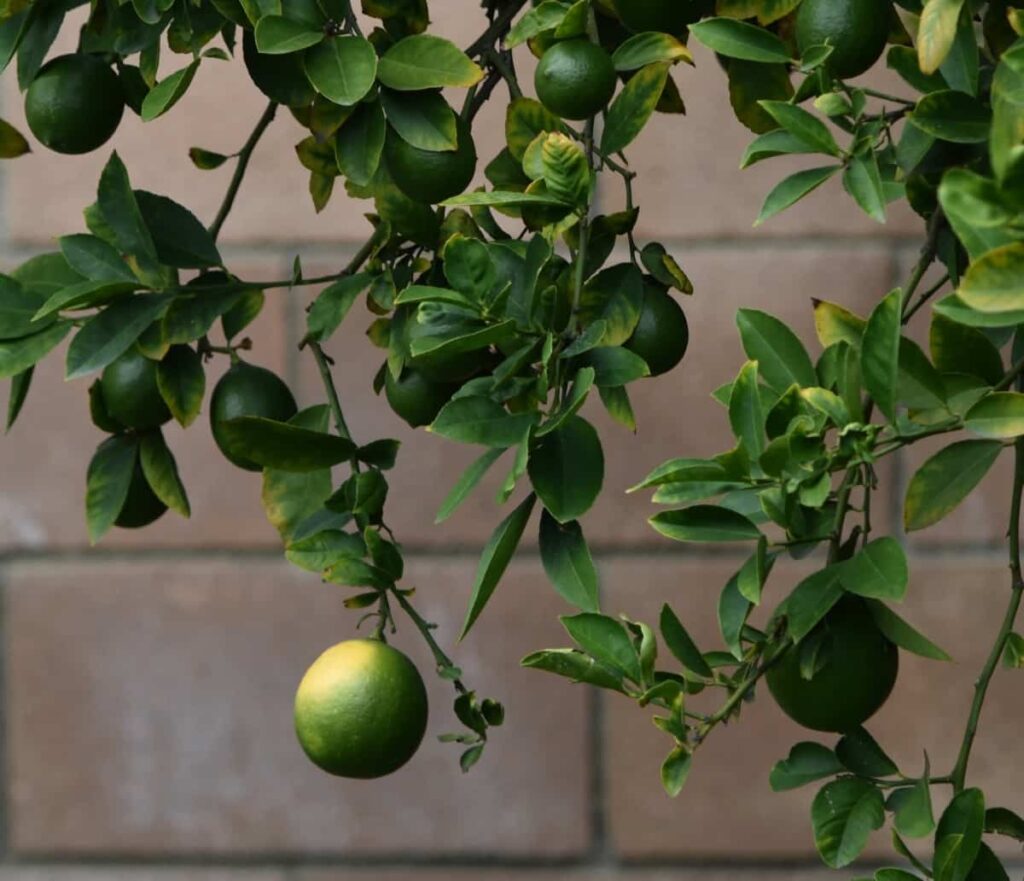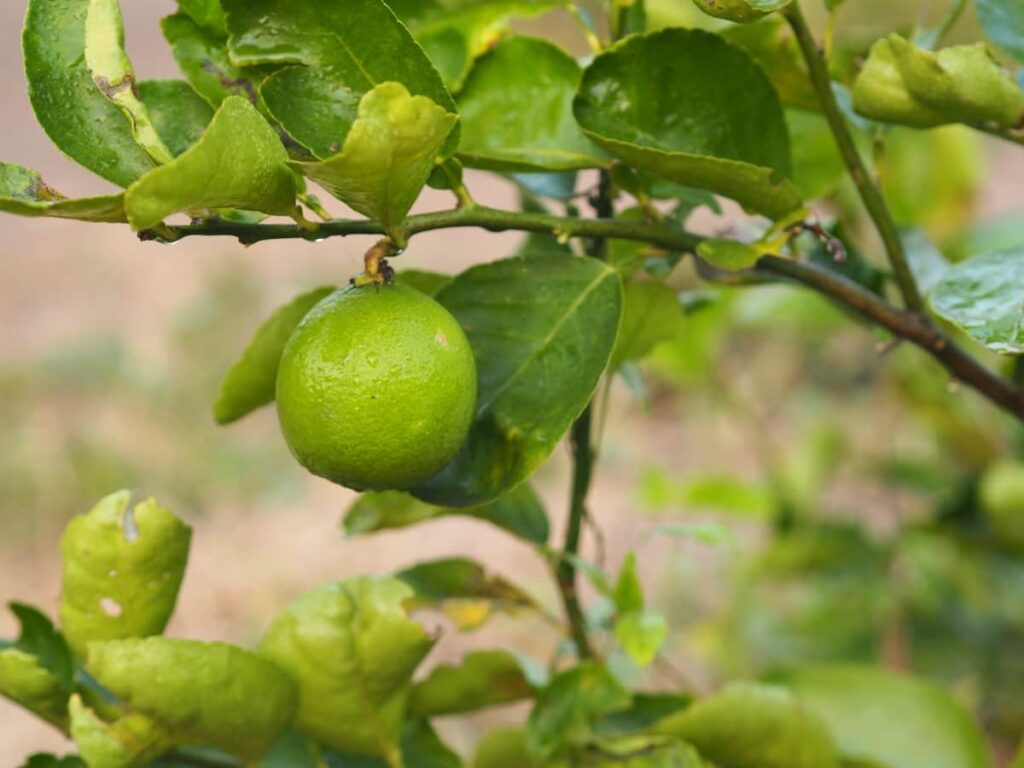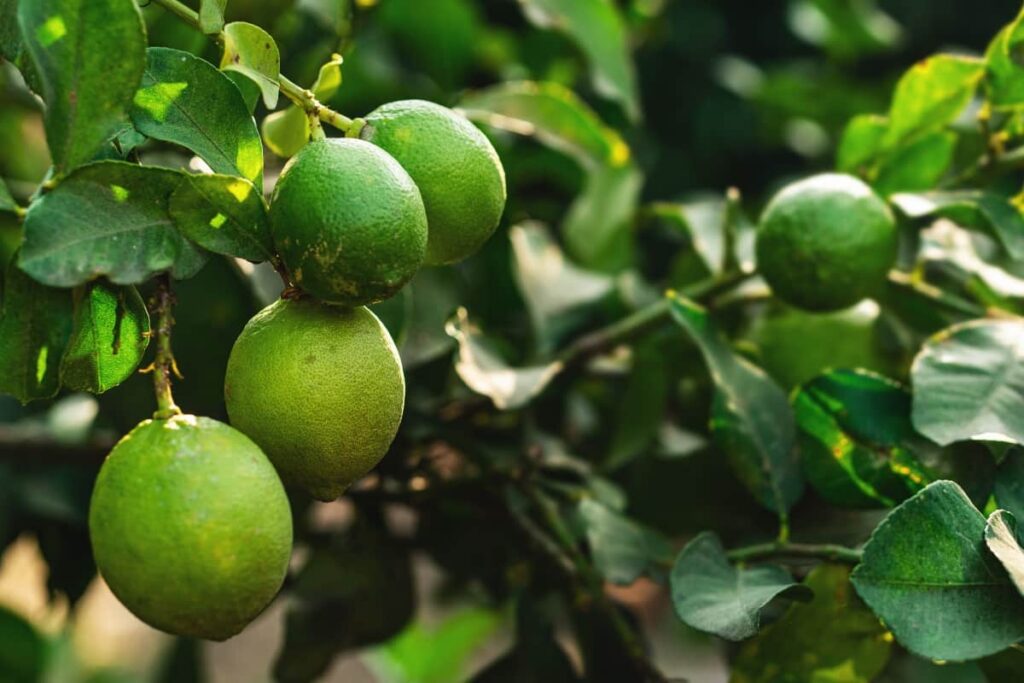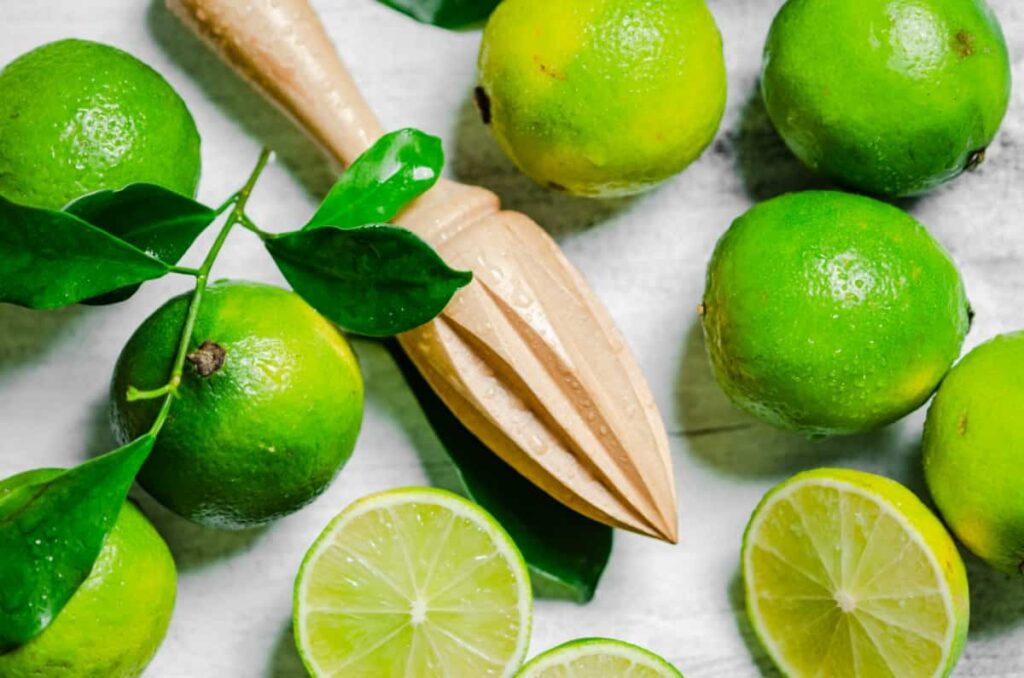Key Lime (Citrus × aurantiifolia), also known as acid lime, Mexican lime, or West Indies lime, is this citrus fruit that hails from tropical Southeast Asia. With its tangy flavor, it has become a beloved staple in culinary dishes and refreshing beverages around the world. Growing Key Lime helps to promote biodiversity by providing a habitat for various beneficial insects, birds, and other wildlife.

Guide to Growing Key Lime
Growing Key Lime Profile
| Attribute | Description |
| Scientific Name | Citrus × aurantiifolia |
| Origin | Southeast Asia |
| Type | Hybrid citrus fruit |
| Appearance | Spherical fruit, glossy oval leaves remain dark green |
| Taste | Tart but not too acidic |
| Tree Size | 8 feet wide and 12 feet tall on the ground |
| Lifespan of Tree | Approximately 50 years |
| Growing Zones | 9 to 11 |
| Seasonality | Throughout the summer and into early fall |
| Culinary Uses | Salad dressings and great for flavoring cakes |
| Storage | At room temperature for 3 to 5 days |
Choosing the Right Variety
When selecting your Key Lime variety, also keep in mind your local climate. Some varieties are better suited for warmer regions with longer growing seasons, while others can tolerate colder temperatures or periods of frost. Choosing the right variety comes down to personal preference and what will thrive in your specific environment.
Planting Your Tree
- Timing: Timing is important for planting your Key Lime tree. Ideally, it would help if you planted it in the spring. This will allow the young tree to establish its roots and grow strong before winter sets in.
- Location: When selecting a location for a Key Lime tree, keep in mind that it thrives in full sun. Look for a spot in your garden that receives at least six hours of direct sunlight each day. Avoid areas with heavy shade or where the tree may be exposed to strong winds.
- Soil: The soil conditions are also important for the successful growth of your Key Lime tree. It prefers well-draining, slightly acidic soil. If you have clay soil, amend it with organic matter to improve drainage.
Propagation Methods
One common propagation method of Key Lime is through seed propagation. This involves collecting seeds from mature Key Limes and planting them in a well-draining mix. However, it’s important to note that growing Key Limes from seeds may result in variations in fruit quality and characteristics. Another option is to use cuttings or scions from existing Key Lime trees. These cuttings can be taken during the dormant season and rooted in a moist rooting medium until they develop their root systems.
In case you missed it: The Ultimate Guide to Growing Meyer Lemon: Best Farming Practices

Grafting is another popular propagation technique for Key Limes. It involves joining a bud or scion from a desired Key Lime variety onto a compatible rootstock. Grafted plants tend to have better fruit quality and disease resistance compared to seed-grown ones. Air layering is yet another method used for propagating Key Lime trees. This technique involves creating roots on an existing branch while it’s still attached to the parent tree, resulting in a new independent plant once severed.
Watering and Mulching
Proper watering ensures that the roots receive adequate moisture, while mulching helps to retain soil moisture and suppress weed growth. For watering your Key Lime tree, consistency is key. The frequency will based on several factors, such as weather conditions, soil type, and tree size.
Mulching around the base of your Key Lime tree offers numerous benefits. It helps to conserve soil moisture by preventing weed competition for nutrients. Organic mulches also improve soil fertility. Regularly check the moisture level of your Key Lime tree’s soil by sticking your finger about an inch into the ground near its root zone. If it feels dry at this depth, it’s time for another watering session.
Fertilizing
By providing the essential nutrients, you can ensure that your tree thrives and produces an abundance of juicy limes. Firstly, it’s important to choose the right fertilizer for your Key Lime tree. Look for a balanced citrus fertilizer with equal amounts of nitrogen, phosphorus, and potassium. This will provide a well-rounded nutrient profile for your tree. When it comes to timing, it’s best to fertilize your Key Lime tree in early spring and again in late summer or early fall. This will coincide with the periods of active growth and fruiting.
To apply the fertilizer, follow the instructions on the packaging carefully. Generally, you’ll want to spread the granules evenly around the drip line of the tree (where water drips from its branches). Be careful not to place them too close to the trunk, as this can affect root burn. After applying the fertilizer, make sure to water it thoroughly. This will help distribute the nutrients into the soil where your Key Lime tree’s roots can absorb them.
Pruning and Training
When it comes to pruning, start by removing any dead or diseased branches. This will enhance the overall tree appearance and also prevent the spread of diseases. Additionally, prune any crossing or rubbing branches to avoid damage. Training your Key Lime tree involves guiding its growth in a desired direction. You can do this by gently bending young branches with ties or stakes. This will help create a balanced structure and allow for easier maintenance in the future.
Regularly inspect your tree for water sprouts – these are rapidly growing vertical shoots that should be promptly removed as they divert energy from fruiting branches. Aim to maintain an open canopy that allows light to reach all parts of the tree. Remember always to use clean and sharp tools when pruning to minimize stress on the tree.
Pest and Disease Management
These citrus trees are susceptible to various pests and diseases that can hinder their fruit production. One common pest that affects Key Limes is the aphid. To control aphids on Key Lime, you can introduce natural predators like ladybugs or use insecticidal soap. Another pest that poses a threat to Key Limes is the citrus leaf miner. This small moth lays its eggs on young leaves, which hatch into larvae that tunnel through the leaf tissue, creating distinctive winding tunnels.
Applying horticultural oil or neem oil can help manage this pest effectively. Citrus greening disease (HLB) is a serious threat to all citrus trees, including Key Limes. To minimize other fungal diseases like root rot or powdery mildew, it’s important not to overwater your Key Lime tree and provide adequate air circulation around the foliage. By implementing pest and disease management practices in Key Lime, you can ensure that your Key Lime tree remains healthy and productive throughout its lifespan.
When and How to Harvest
Knowing the right time to harvest your Key Limes is essential for enjoying their delicious flavor. Look for signs of maturity in the fruit. The color of ripe Key Limes is typically bright green or yellowish-green. They should feel firm yet slightly soft when gently squeezed. Another way to check if your Key Limes are ready for harvest is by their size.
In case you missed it: Mastering Kagzi Nimboo Farming: A Comprehensive Kagzi Lemon Cultivation Guide

Mature fruits usually range from 1-2 inches in diameter, depending on the variety. To pick your Key Limes, gently twist them from the tree using your hand or a pair of clippers. Once harvested, it’s important to handle them with care as they can be easily bruised. Store them in a cool and dry place away from direct sunlight.
Common Challenges
- Nutrient deficiencies: Like any other plant, Key Lime trees need proper nutrition to thrive. Nutrient deficiencies can affect stunted growth, yellowing leaves, and poor fruit development.
- Temperature sensitivity: While Key Limes love warm weather, they are sensitive to extreme temperatures. Cold snaps or heatwaves can damage or even kill the tree if not protected.
- Pruning mistakes: Improper pruning techniques can result in weak branches or over-pruned trees that struggle to produce fruits.
- Watering issues: Overwatering or underwatering your Key Lime tree can cause root rot or drought stress, respectively. Growers need to stay vigilant and address these challenges promptly to ensure healthy growth and a bountiful harvest.
Yield
The yield of a Key Lime tree can change based on several factors, including age, health, and environmental conditions. Generally speaking, a mature and well-maintained Key Lime tree can produce anywhere from 50 to 60 pounds of fruit per year.
In case you missed it: High Yield Hybrid Lemon Varieties in India

Conclusion
Growing your Key Lime tree can be incredibly rewarding. Having access to fresh Key Limes right in your backyard means you can enjoy their tangy flavor in various culinary creations. Growing your own Key Limes reduces reliance on store-bought produce that could have traveled long distances or been treated with chemicals. This promotes sustainability while ensuring you have access to high-quality fruit at its peak freshness.
- Management Pests and Diseases in Your Cotton Field
- Sheep Farming Business Plan for Beginners
- Aquaponic Farming at Home: A Step-By-Step Guide
- Profitable Village Farming Business Ideas in 2024
- High-Yield Aquaculture: Fast-Growing Fish for Farming
- Effective Fish Pond Construction Techniques for Beginners
- Irrigation and Water Management in Pineapple Farming
- Blossom to Harvest: Mastering Flowering and Pollination in Papaya Farming
- Pig Fattening Essentials: From Selection to Sale for Beginners
